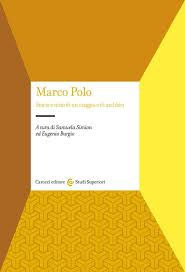Marco Polo Research: Past, Present, and Future, Tübingen: Tübingen Library Publishing, 2024
- ailicwebmaster
- Aug 14, 2024
- 3 min read
Hans Vogel and Ulrich Theobald (eds.)
Marco Polo Research: Past, Present, and Future
Tübingen: Tübingen Library Publishing, 2024. 505 Pp.

This year marks the seventh centenary of the death of Marco Polo. The figure of the Venetian traveler has long captivated historians, geographers, and the general public alike. The scholarly study of Marco Polo’s work, which began in earnest in the early 19th century, has revealed the vast and complex nature of his travelogue, encompassing various themes and requiring input from diverse academic disciplines. Marco Polo Research: Past, Present, and Future, edited by Hans Vogel and Ulrich Theobald, offers a comprehensive compilation of this scholarly tradition. The book brings together research from scholars with different cultural backgrounds and fields, aiming to offer a more coherent analysis of Marco Polo's text, covering a wide range of topics, from the history of the book’s transmission and its position in medieval literature to comparisons of Polo’s observations with historical facts verified from native sources.
Marco Polo Research: Past, Present and Future is organized into three broad sections, each corresponding to a phase in the historiography of Marco Polo's travels. The first section, “Le Devisement dou monde: History and Digitization of the Text(s)” gather contributions by Philippe Ménard, Alvise Andreose, Samuela Simion, Mario Eusebi, Eugenio Burgio, Giuseppe Mascherpa and Michel Quereuil, revisits the studies and interpretations in the history of philological studies on the textual tradition of the Devisement dou Monde, the original title of Polo’s narrative. Menard and Andreose, in particular, focus on the current landscape of critical studies on Polo’s text. Simion, Eusebi and Burgio on the other describe an interesting project of digitalization of the text of the Devisement dou Monde being currently develops at the Ca’ Foscari University in Venice. Mascherpa and Quereuil instead focus on the specific philological tradition, and textual variations, concerning two topical sections in Polo’s boook: the description of Qinsay/Hangzhou and Tibet respectively.
The second part of the volume, “Reception and Styles of the Book, and the Literary Field” delves into an interdisciplinary approach, drawing on history, geography, translation and literary studies, gatehring contributions by Marcello Ciccuto, Christine Gadrat-Ouerfelli, Sharon Kinoshita, Danièle James-Raoul, Dominique Boutet and Michèle Guéret-Laferté. The contributors examine various aspects concerning the reception and internal stylistic organization of Polo’s narrative, with a gamut of critical forays ranging from the study of illuminated versions of Polo’s manuscripts (Ciccuto) to the reception of his text among medieval readers (Gadrat-Ouerfelli), the role of literary exoticism in Polo’s description Asia (Boutet) up to more specific analyses devoted for instance to Polo’s account of Persia (Guéret-Laferté) or the role of translation in the critical receptions of the Devisement (Kinoshita).
The third and final section of Marco Polo: Past, Present and Future, “Marco Polo’s Reports and the World He Witnessed” gathers contributions from Tang Li, Dang Baohai, Luo Wei, Ulrich Theobald, Stephen Haw and Hans Ulrich Vogel, which explores the contents and historical accuracy of Polo’s work. This broad and interdisciplinary section of the book touches on topics as diverse, and fascinating, as the portrayal of Nestorian Christianity in the Devisement (Tang), lexical and geographical clarifications of terms and passages of particularly complex interpretation (Dang, Haw), as well as Polo’s cultural attitudes to the political history of Asia and the Mongol empire (Luo and Theobald). Hans Vogel’s final article, eventually, offers a captivating and original exploration of animal descriptions in the Devisement dou Monde, focusing on Polo’s references to “crouching dragons and hidden tigers” that the reader can found in the pages of the Devisament.
The contributors to this volume, experts in their respective disciplines, draw upon diverse sources and methodologies to provide a valuable critical summary on the state of Marco Polo research. Their work offers a much-welcomed contribution to our comprehension of the Venetian's account and the historical context in which it was produced, as well as aids in validating and clarifying the various statements found across the numerous versions and editions that have survived, marking an apt tribute to 700th anniversary of the death of Marco Polo.
Tommaso Pepe
Wenzhou-Kean University




